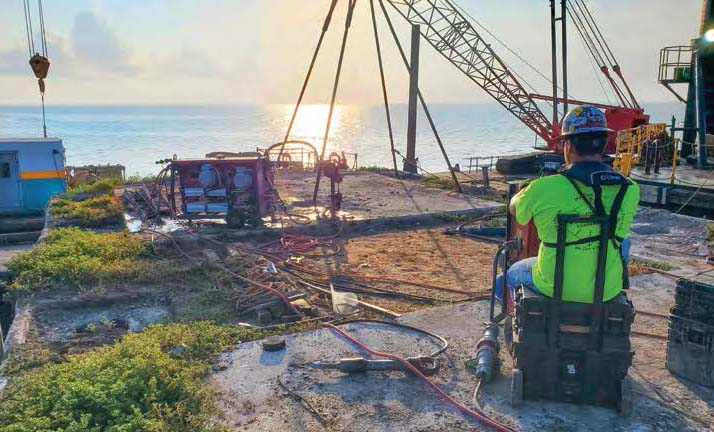
CSDA Contractor Drills Nearly 5,000 Holes in South Texas Concrete Ahead of Schedule

T exas is well-known for its abundant oil energy, but the Lone Star State is also a global leader in wind energy: Texas produces more wind power than any other U.S. state and exceeds all but four countries in wind capacity. Wind power accounts for 17.6% of the state’s total power output and wind farms produced nearly 85,000 kilowatt hours of energy in 2019. South Texas in particular is a hotspot for wind energy, where thousands of wind turbines, 300 to 600 feet high, dot the vast landscape, dwarfing cell phone and water towers.

In January 2020, Greg Burley, General Manager for the San Antonio division of Texas Cutting and Coring, received a call from a general contractor (GC) who was in a tough situation. The GC was tasked with expanding the bases of 118 wind turbine foundations on a wind farm in South Texas. Eighty 1 3/8-inch diameter holes needed to be drilled 48 inches deep in the existing foundations to accommodate the new concrete pour. However, concrete in southern Texas is notoriously extremely hard and can be difficult to drill. The general contractor had tried to drill the dowel holes with rotary hammers, but they were no match for the dense concrete and steel reinforcement they ran into on every attempt. The GC was now lagging behind on the job timetable, with no holes completed. They needed a professional concrete cutter’s help, and fast.
Texas Cutting and Coring (TCC) sent two crews with supervisors to the site to drill some test holes so they could decide what bits and tools would work best for the job. Getting their team to the wind farm was an adventure in itself. The front gate of the wind farm was 30 minutes from the closest town. From the gate, the nearest wind turbine was 45 minutes down a caliche road. From the first wind turbine to the farthest was an additional 30 minutes. That’s a lot of mileage before even powering up your tools
During testing, the Texas Cutting and Coring team confirmed that the concrete was indeed very hard. It not only included the expected river rock mix, but also a very abrasive sand and heavy reinforcement. The steel reinforcement was also confirmed, with the team finding #5 and #10 rebar in the concrete, anywhere from 2 inches to 20 inches of reinforcement. The testing team’s bits wore out before completing even one hole, but they eventually were able to average one to two holes per bit. At this point, TCC knew that it was going to be exceedingly difficult to complete the job without significant changes in equipment and more manpower than anticipated. They informed the GC that it would be a challenge to complete the number of holes requested each day, but the GC instructed TCC to continue drilling until the job was complete.
TCC was using drill bits from Diamond Products, DDM Concut, DITEQ Corp. and K2 Diamond. As this project was ramping up at the same time as the COVID-19 pandemic, delays began to arise in acquiring and delivering those bits to South Texas due to supply chain issues. Yet the suppliers went above and beyond to supply TCC with all the bits they needed as quickly as possible.
Looking for a solution to speed up drilling, TCC spoke with a friend in the concrete industry who recommended they try Shibuya Auto Feed core drills. After a call to DITEQ Corp, a complete Shibuya demo core rig with Shibuya Auto Feed was shipped overnight to the jobsite. In only four hours of working with the Shibuya drill, the TCC crew could clearly see a huge improvement in bit life and the time it took to drill each hole. They immediately ordered nine Shibuya Auto Feed core rigs, which arrived on the job site within four days. Production and bit life doubled, and in some cases, tripled. These Auto Feed drills were the perfect fit for drilling these longer cores in a very hard, reinforced concrete. The Auto Feed function essentially acts as “the perfect operator” and allows the speed to be automatically adjusted when the bit hits rebar. The speed slows, optimizing the life of the bit and the amperage of the drill. Sometimes on longer cores, if the bit is forced into a cut too quickly, the bit can “wander” or “walk” which then causes the hole to not be perfectly straight. Fortunately, TCC never ran into this problem because they found the right tool for the job.
The new Shibuya tools were what TCC needed to make up for lost time and the expenses they had already incurred. The GC also brought in two other professional concrete cutting companies to help out with the large quantity of holes.
Texas Cutting and Coring’s Tomas Acevedo coordinated all the crews. Under his outstanding supervision, they completed the drilling in eight weeks, four weeks ahead of schedule. The crew started with four operators for the first three weeks, then increased to six operators for the rest of the project. In all, they drilled approximately 4,920 1 3/8-inch holes 48 inches deep. After the arrival of the Shibuya core drills, drilling time decreased from one hour per core to 20 minutes. All nine Shibuya Drills and Auto Feeds ran 12 hours a day and 7 days a week for 8 weeks, and not one quit working. The other two professional concrete cutting companies completed the drilling on the remaining 58 towers, for approximately 4,800 holes.
Burley, who oversaw this entire project for TCC, commented, “Our ability to bring ingenuity and creative solutions to a difficult and complex drilling job helped the GC finish the job ahead of schedule and made them a very happy customer.”
TCC did have to take some extra precautions beyond the standard PPE their operators normally wear. The combination of the COVID-19 pandemic and working in an outdoor environment with high winds blowing sand across the drilling area meant operators wore face shields, fully-enclosed safety glasses and N-95 masks.
The GC was thrilled with the outcome of the project, especially that it was completed ahead of schedule after the initial delays. They stated “We knew that TCC would figure it out. We could see the determination and effort put in by everyone at Texas Cutting and Coring and had all of the faith in the world that they would figure it out.”
Only a CSDA contractor will be able to determine not only the right method for a concrete cutting job, but also the right tools. This knowledge comes from years of experience. Texas Cutting and Coring has the knowledge, experience, training and supplier relationships to complete complicated jobs like these successfully.
COMPANY PROFILE
Texas Cutting and Coring was founded in 1997 and operates over 40 trucks in their commercial division, employing approximately 110 people. The main office is located in Austin, with branches in San Antionio and College Station. They offer the services of: Soffcut control joint sawing and sealing, full depth slab sawing (electric and diesel), core drilling (electric and diesel), wall sawing (electric and hydraulic), wire sawing (electric and hydraulic), curb sawing, barrier wall sawing, concrete demolition and haul off, robotic demolition, surface preparation (sand blast, shot blast, floor grinding, milling), GPR scanning and utility scanning. They specialize in bridge barrier and bridge deck concrete sawing as well as structural concrete demolition. They have been CSDA members since 2011.
RESOURCES
Concrete Coring Contractor
Texas Cutting and Coring
Greg Burley
Phone: 210-885-8789
Email: greg@texascurbcut.com
Methods Used: Core Drilling














